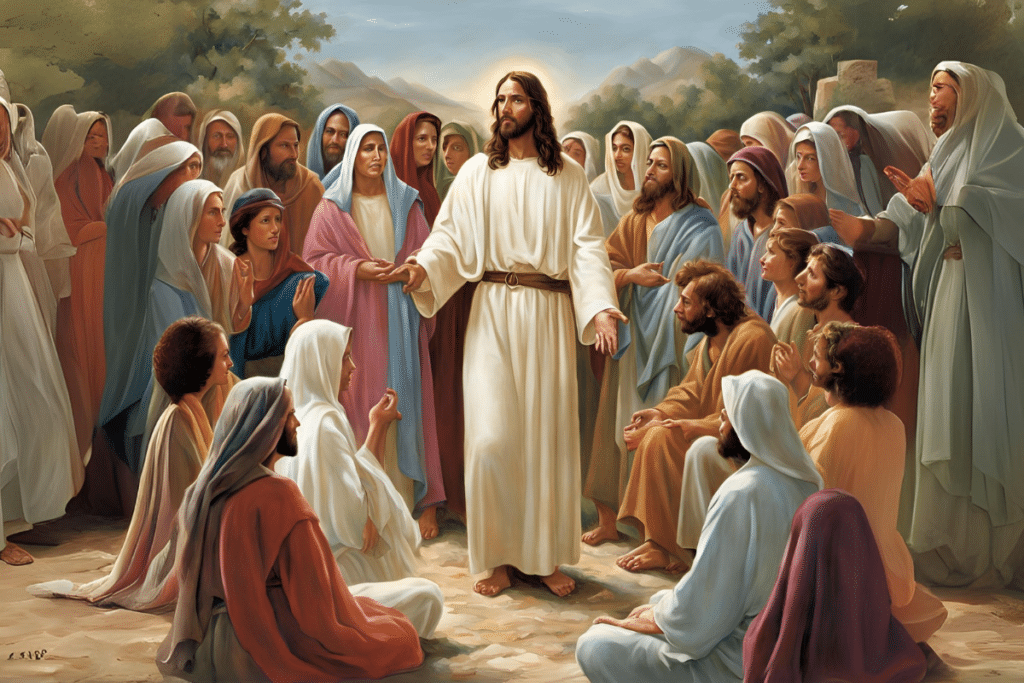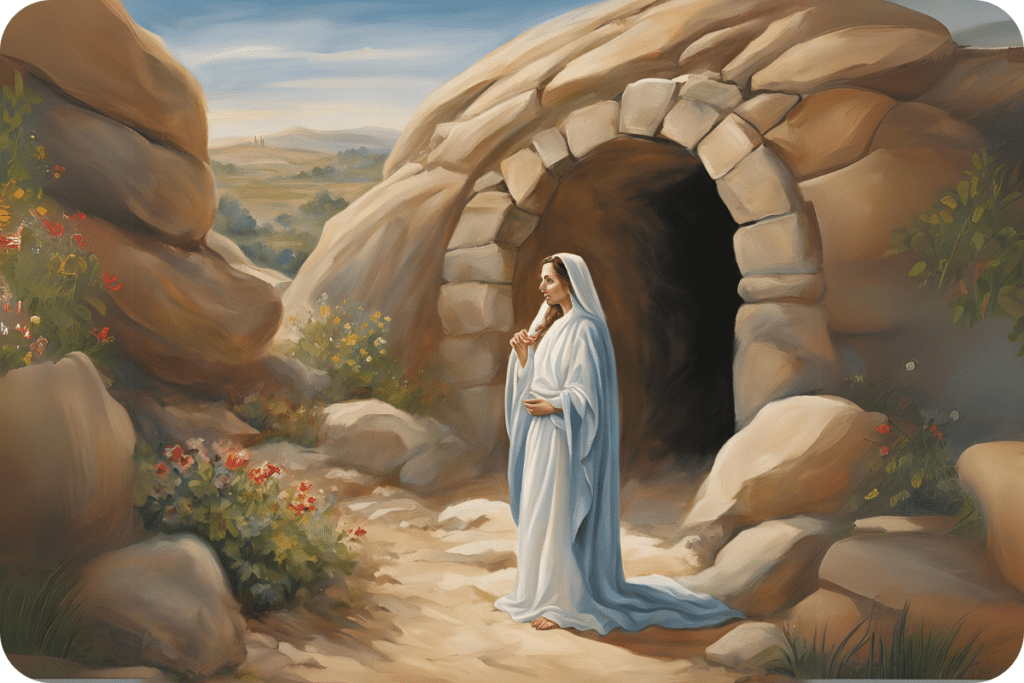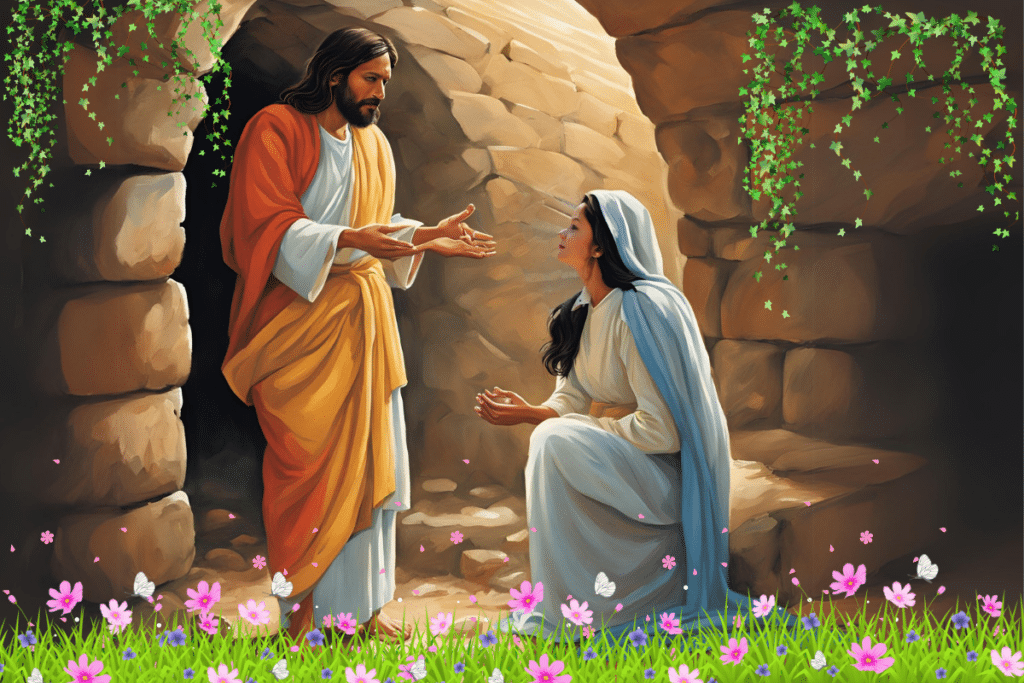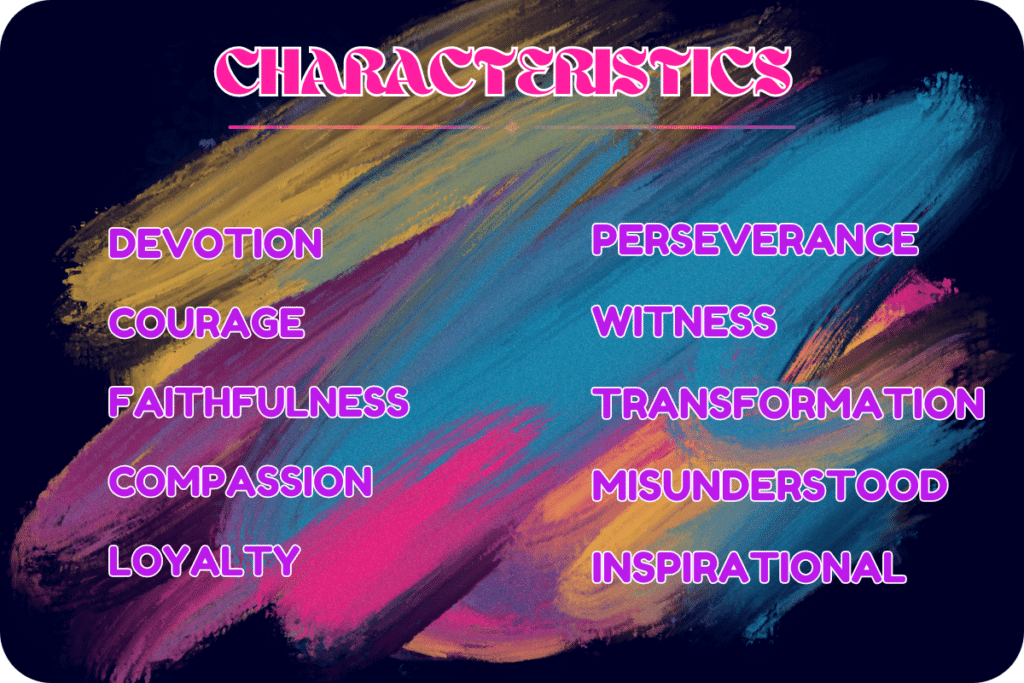MIRACULOUS MARY MAGDALENE IN THE BIBLE
Mary Magdalene is a significant figure in the New Testament, recognized for her unwavering devotion to Jesus Christ. She is mentioned in all four gospels, highlighting her crucial role as a follower who supported Jesus’ ministry. Mary witnessed both the crucifixion and the resurrection, being the first to discover the empty tomb and encounter the risen Christ, which earned her the title “Apostle to the Apostles.”

Despite historical misconceptions conflating her with sinful women, recent scholarship has restored her image as a devoted disciple, symbolizing redemption and faith within early Christianity
Who Was Mary Magdalene?
Mary Magdalene, often referred to simply as “Mary,” was a devoted follower of Jesus Christ, mentioned in all four canonical gospels. Her name, “Magdalene,” signifies her origin from Magdala, a town on the Sea of Galilee.
She is notable for being present at key events, including the crucifixion and resurrection of Jesus, where she was the first to witness the empty tomb and encounter the risen Christ. Despite her significance, many myths surround her, often misrepresenting her character and role in early Christianity, leading to a complex legacy that continues to intrigue scholars and believers alike.
Mary Magdalene in the Gospels
Mary Magdalene in the Gospel of Matthew
In the Gospel of Matthew, Mary Magdalene is prominently featured as one of the women who witnessed Jesus’ crucifixion and burial. She, along with another Mary, visits the tomb early on the first day of the week, discovering it empty.
Mary Magdalene is notably the first person to see the resurrected Christ, highlighting her crucial role in the resurrection narrative. This emphasizes her importance in early Christianity, as she is entrusted with the message of Jesus’ resurrection, making her a key figure in the foundation of the faith.
Mary Magdalene in the Gospel of Mark
The Gospel of Mark emphasizes Mary Magdalene’s significant presence during critical events in Jesus’ life, including his crucifixion and resurrection. She is named among the women who followed and supported Jesus, indicating a close relationship. Mark highlights her as the first person to witness the resurrected Christ, showcasing her vital role in the resurrection narrative.
After Jesus appears to her, she becomes the messenger of his resurrection, tasked with informing the disciples, which underscores her importance in early Christianity and her status as a key figure among Jesus’ followers.
Mary Magdalene in the Gospel of Luke
Luke’s Gospel uniquely mentions that Jesus healed Mary Magdalene of seven demons, providing insight into her background. This detail has been misinterpreted, leading to the misconception that she was a sinful woman. However, scholars suggest the number “seven” may symbolize the severity of her affliction or the number of exorcisms required to free her from demonic possession.
Regardless, Mary’s suffering must have been immense, both physically and psychologically. Jesus’ healing was a profound act of compassion that transformed her life, igniting a deep devotion that compelled her to support his ministry and become a key witness to his crucifixion and resurrection.
Mary Magdalene in the Gospel of John
In the Gospel of John, Mary Magdalene plays a pivotal role in the resurrection narrative. She is the first to discover the empty tomb, arriving while it is still dark. After informing Peter and another disciple, she encounters the risen Jesus, initially mistaking him for a gardener.
Upon recognizing him, she is instructed by Jesus to go and tell the disciples about his resurrection. This encounter emphasizes her significance and has led to her being referred to as the “Apostle to the Apostles,” highlighting her vital role in proclaiming the resurrection to the early Christian community.
Mary Magdalene’s Relationship with Jesus
Mary Magdalene’s relationship with Jesus is characterized by profound loyalty and spiritual connection. As a devoted follower, she remained present during the crucifixion when most male disciples fled, showcasing her courage and commitment. Her role as the first witness to the resurrection further emphasizes her significance in Christian history, placing her at the heart of the resurrection narrative.

This pivotal moment not only highlights her faith but also establishes her as a key figure in proclaiming the resurrection, reinforcing her importance in early Christianity and her enduring legacy as a symbol of devotion and witness to Jesus’ transformative power.
The First Witness of the Resurrection
Mary Magdalene’s encounter with the risen Jesus is a profound moment in the New Testament, marking her as a foundational figure in Christian belief. She discovers the empty tomb and, in her grief, initially mistakes Jesus for a gardener until he calls her name, revealing his identity.

This personal interaction underscores her significance, as Jesus instructs her to share the news of his resurrection with the disciples, establishing her role as the “Apostle to the Apostles.” Her testimony is crucial, solidifying the resurrection’s importance in Christian faith and highlighting her deep spiritual connection to Jesus.

Mary Magdalene in Early Christian Writings
Beyond the canonical gospels, Mary Magdalene appears in various early Christian writings, including apocryphal texts and Gnostic gospels. In these writings, she is often depicted as a close companion of Jesus, with some texts suggesting she possessed special insight into his teachings.
For instance, the Gospel of Mary portrays her as a visionary and leader, indicating that Jesus loved her more than the other disciples. This portrayal contrasts with her representation in the canonical gospels, where her role is more subdued, highlighting the diverse interpretations of her character in early Christian thought.
Misconceptions About Mary Magdalene
The persistent myth that Mary Magdalene was a repentant prostitute likely stems from a conflation of her story with those of other unnamed women in the Bible. This misconception began in 591 CE when Pope Gregory I suggested that she was the sinful woman from Luke 7:36-50, despite no biblical evidence supporting this claim.
Modern scholarship has clarified that the New Testament only identifies her as a woman from whom Jesus cast out seven demons, emphasizing her role as a devoted follower rather than a sinner. Efforts continue to correct this erroneous view and highlight her true significance in early Christianity.
Mary Magdalene in Art and Culture
Mary Magdalene has been a popular subject in art and culture for centuries. During the Renaissance, she was often depicted as a penitent sinner, reflecting the belief that she was a former prostitute, a misconception stemming from conflating her story with that of other biblical women.
Artists like Donatello and Guido Reni portrayed her in ways that emphasized her remorse and spiritual transformation. In modern interpretations, Mary Magdalene has been reimagined as a feminist icon and a symbol of spiritual awakening, showcasing her complex legacy that continues to inspire diverse artistic expressions and cultural narratives today.
The Legacy of Mary Magdalene
Mary Magdalene’s legacy is multifaceted, revered in Christianity as a saint and model of devotion. Her unwavering faith and pivotal role as a witness to Jesus’ crucifixion and resurrection have solidified her importance in the Christian narrative. Beyond religious contexts, she has influenced art, literature, and modern discussions about women’s roles in the church, often serving as a symbol of redemption and spiritual transformation.
Her story continues to inspire and challenge believers and scholars, prompting ongoing exploration of her significance and the complexities of her portrayal throughout history.
Mary Magdalene in Modern Theology
In contemporary theology, Mary Magdalene is often reinterpreted through a feminist lens. Many modern theologians argue that her leadership role among Jesus’ followers has been diminished in traditional accounts. Feminist scholars emphasize her prominence in the Gospels as a witness to the crucifixion and resurrection, suggesting she held a position of authority in early Christianity.
This reexamination has led to a renewed appreciation of her contributions and a call for greater recognition of women’s roles in the church. However, some caution that this feminist reading may overlook the significance of her repentance and redemption in the Christian tradition.
Pilgrimages and Sites Associated with Mary Magdalene
Mary Magdalene is associated with several significant pilgrimage sites worldwide, particularly in France and Jerusalem. Her purported burial site in Saint-Maximin-la-Sainte-Baume, where the Basilica of Sainte Marie Madeleine stands, is a major destination, believed to house her relics.
Additionally, the Church of Saint Mary Magdalene in Jerusalem marks her historical presence. These locations hold deep historical and spiritual significance, attracting pilgrims seeking to connect with her legacy. The pilgrimage trails, such as the new route in Provence, trace her journey after the resurrection, emphasizing her enduring influence in both religious and cultural contexts.
The Feast of Mary Magdalene
On July 22, the Catholic Church celebrates the Feast of Saint Mary Magdalene, honoring one of the most prominent women in the New Testament. Special masses, prayers, and reflections mark this day, emphasizing her pivotal role in the life of Jesus and the early church.Mary Magdalene was a devoted follower of Jesus, present at his crucifixion and the first witness to his resurrection.
The Gospels record her as the first person to encounter the risen Christ, who entrusted her with the message of his resurrection to share with the apostles.This feast day serves as a reminder of Mary Magdalene’s significance as a disciple and apostle, and the Church’s recognition of her important place in salvation history.
The Gospel of Mary Magdalene
The Gospel of Mary, an apocryphal text discovered in the 5th century, offers a unique perspective on Mary Magdalene’s role in early Christianity. Though not part of the biblical canon, this gospel portrays her as a prominent disciple who received special teachings from Jesus. It depicts her as a visionary and leader, suggesting she held a position of authority among the apostles.
The text has been the subject of much scholarly debate, with some arguing it was originally independent of Christian influence. The Gospel of Mary continues to intrigue those interested in early Christian history, providing insights into the controversies surrounding Mary Magdalene’s place in the church.
Mary Magdalene as a Symbol
Mary Magdalene’s story represents powerful ideals within Christianity – repentance, devotion, and witness to the truth. Her transformation from a woman healed of demons to a devoted follower of Jesus exemplifies the redemptive power of faith. As a witness to the crucifixion and the first to proclaim the resurrection, she is a symbol of courage and the importance of bearing witness.
Different Christian traditions have interpreted her story in diverse ways, reflecting her enduring relevance. In the Catholic Church, she is honored as a saint, with a feast day on July 22. In feminist theology, she is reimagined as a prominent disciple and apostle, challenging patriarchal structures. Mary Magdalene’s complex legacy continues to inspire and challenge believers, making her a timeless figure of hope and redemption.
Lessons from Mary Magdalene in the Bible
Mary Magdalene’s story in the Bible offers several profound lessons that resonate with many believers:
1. The Power of Faith and Devotion
Mary Magdalene’s unwavering faith in Jesus, even during his crucifixion, teaches the importance of steadfast devotion. Her presence at the cross and the tomb shows that true faith endures even in the darkest moments.
2. Redemption and Transformation
Mary Magdalene’s life exemplifies the power of redemption. Jesus healed her from “seven demons,” symbolizing a deep transformation. This teaches us that no matter our past, we can be renewed and find a new purpose through faith.
3. Courage in the Face of Adversity
Mary Magdalene showed immense courage by standing by Jesus during his crucifixion when many others had fled. Her actions remind us to remain strong and faithful, even when faced with fear and uncertainty.
4. The Importance of Witnessing
As the first to witness the resurrection, Mary Magdalene’s role as a witness highlights the importance of sharing the truth. Her testimony was crucial in spreading the message of Jesus’ resurrection, teaching us the value of bearing witness to our faith.
5. Breaking Misconceptions
Mary Magdalene’s story also teaches us about overcoming societal misconceptions. Despite being wrongly labeled for centuries, her true legacy as a devoted follower of Jesus shines through, reminding us not to judge others based on false assumptions.
6. The Role of Women in the Church
Mary Magdalene’s prominent role in the resurrection story shows that women have a vital place in the Christian faith. Her example encourages the recognition and appreciation of women’s contributions to spiritual life and leadership.
7. Loyalty and Service
Her consistent support of Jesus and the disciples illustrates the importance of loyalty and service in our spiritual lives. Mary Magdalene’s dedication to serving others is a model for how we should care for and support our communities.
8. Hope in Resurrection
Mary Magdalene’s encounter with the risen Christ symbolizes hope and renewal. Her experience teaches us that even in the face of death and despair, there is hope for a new beginning through the resurrection.
9. Perseverance in Seeking Jesus
Despite her grief, Mary Magdalene went to the tomb early in the morning, demonstrating her perseverance in seeking Jesus. This teaches us the value of persistently seeking a deeper relationship with God, even when we feel lost or alone.
10. Being a Messenger of Good News
After seeing the risen Jesus, Mary Magdalene was entrusted with delivering the message of his resurrection to the apostles. Her role as a messenger reminds us of the responsibility we have to share the good news and spread hope to others.
Characteristics of Mary Magdalene in the Bible

Mary Magdalene is a prominent figure in the New Testament, known for her close association with Jesus Christ. Her characteristics, as depicted in the Bible, include:
1. Devotion
Mary Magdalene was deeply devoted to Jesus, following him throughout his ministry. She is often described as one of the women who supported Jesus and his disciples, both spiritually and materially.
2. Courage
Mary Magdalene demonstrated remarkable courage, particularly in her presence at the crucifixion of Jesus. While many of Jesus’ male disciples fled, she remained by his side during his suffering and death.
3. Faithfulness
Her faithfulness is evident in her role as the first person to witness the resurrection of Jesus. She was the one who found the empty tomb and later encountered the risen Christ, making her a key witness in the Christian faith.
4. Compassion
Mary Magdalene’s compassion is seen in her willingness to care for Jesus and the other disciples. She was part of a group of women who traveled with Jesus, providing for their needs out of their own resources.
5. Loyalty
Her loyalty to Jesus is highlighted by her presence at both the crucifixion and the resurrection. Despite the danger and uncertainty, Mary Magdalene remained steadfast in her commitment to him.
6. Perseverance
Mary Magdalene’s perseverance is evident in her actions following Jesus’ death. She went to the tomb early in the morning to anoint his body, demonstrating her enduring love and dedication, even in the face of grief.
7. Witness
As the first to see the resurrected Jesus, Mary Magdalene plays a crucial role as a witness in the Christian narrative. Her testimony was vital in spreading the news of Jesus’ resurrection to the other disciples, earning her the title “Apostle to the Apostles.”
8. Transformation
Her life story is often viewed as one of transformation. Jesus healed her from “seven demons,” symbolizing a significant personal change and a new beginning in her life as a follower of Christ.
9. Misunderstood
Throughout history, Mary Magdalene has been a misunderstood figure, often wrongly associated with sinfulness or portrayed as a repentant prostitute, a misconception that has been widely debunked by modern scholars.
10. Inspirational
Mary Magdalene’s unwavering faith, courage, and devotion make her an inspirational figure for many. She is seen as a model of discipleship and a symbol of the transformative power of Jesus’ teachings.
Conclusion
Mary Magdalene’s story is one of the most compelling in the New Testament, exemplifying faith, devotion, and courage. As a devoted follower of Jesus, she supported his ministry and witnessed his crucifixion and resurrection. Despite misconceptions portraying her as a repentant sinner, modern scholarship emphasizes her role as a prominent disciple.Mary Magdalene’s encounter with the risen Christ made her the “apostle to the apostles”, entrusting her with the message of the resurrection.
This pivotal moment solidified her significance in early Christianity and her enduring legacy as a symbol of transformation and witness to the truth.Her story continues to inspire believers and challenge traditional gender roles, reminding us of the profound impact one person can have on the course of history.
Reference
Unique FAQ’s
Was Mary Magdalene really a prostitute?
No, there is no biblical evidence to support the idea that Mary Magdalene was a prostitute. This misconception likely arose from a conflation of her story with other women in the Bible.
Why is Mary Magdalene called the “Apostle to the Apostles”?
Mary Magdalene is called the “Apostle to the Apostles” because she was the first to witness the resurrected Jesus and was tasked with telling the disciples about his resurrection.
What is the significance of Mary Magdalene in Gnostic texts?
In Gnostic texts, Mary Magdalene is often portrayed as a close companion of Jesus with a deep understanding of his teachings. She is sometimes depicted as a leader among the disciples.
How is Mary Magdalene viewed in modern Christianity?
In modern Christianity, Mary Magdalene is increasingly recognized for her true role as a devoted follower of Jesus and the first witness to the resurrection. Her story is often reexamined through feminist and scholarly lenses.
What are some common misconceptions about Mary Magdalene?
Common misconceptions about Mary Magdalene include the belief that she was a prostitute or a sinful woman. These views have been debunked by modern scholarship, which emphasizes her importance as a key figure in the early Christian church.


1 thought on “3. MIRACULOUS MARY MAGDALENE IN THE BIBLE”